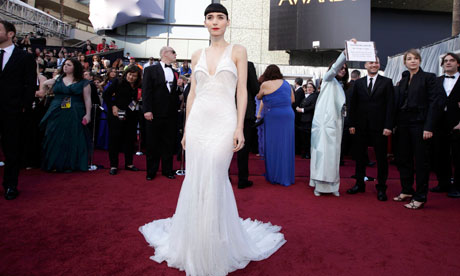
Hollywood declared its love for silent film homage The Artist at the Oscars last night – including the statue for best costume design – but this season, the fashion world drew inspiration from the real thing, a 1920s sci-fi spectacular called Metropolis.
The movie, directed in 1927 by Fritz Lang, is set in an urban dystopia where planes glide between the summits of lofty skyscrapers, where the boss class lives luxuriously in the fresh air at the very top – and the workers go home to underground slums, after punishing shifts operating the mechanisms that power the city. The workers want to rebel, but are guided by a young teacher, Maria, who preaches unity and patience. That's where the shock-haired, wild-eyed scientist Rotwang and his future-tech creation, a "machine-man" robot, come in. Rotwang, in cahoots with the factory owner, makes over his robot to look like Maria, but with a wicked gleam in her kohl-circled eyes. This irresistible, fake Maria whips the workers into a frenzy, and together they storm the factory, leading to a flood and the threat of a terrible catastrophe ...
The design of the film is just as thrilling as the plot, and at the Paris couture shows this year, Givenchy's Riccardo Tisci and Versace's Donatella both revealed themselves as Metropolis fans. Givenchy's tightly sculpted, embellished gowns from the spring/summer 2012 collection channelled the movie's gothic-industrial vibe, while Versace's metal ridge details, flaring on the hip and accentuated cups on corseted tops, were pure fembot chic. Describing her collection, Donatella Versace called her models "warrior women", pushing the aggressive side of her designs.
Tom Ford's collection at London fashion week has been kept away from the cameras – but he too claimed Metropolis as an influence and Guardian fashion editor Jess Cartner-Morley praised the collection's hard-edged glamour – "tight leather and sinuous crepe, bags with polished golden hardware and sharp-pointed stiletto boots". In Milan last week, Max Mara became the latest label to pay tribute to Lang's futuristic nightmare, with a collection of overalls, dungarees and heavy caps that remodelled the utilitarian clothes of the workers of Metropolis in crocodile skin and cashmere. And when Rooney Mara wore one of Givenchy's ice-white, fitted gowns, to the Oscars last night, her vampiric makeup emphasised the look's cinematic heritage.
So why Metropolis? Isn't it a rather obscure reference point? Well no, even if you've never seen Metropolis, you've seen a film, a dress, a building or a pop video that was inspired by it. The film's look – the teetering architecture, the lever-and-dial mechanisms, the round-shouldered workers marching in unison, and of course, the robot – is the Sex Pistols at the Lesser Free Trade Hall of the design world. Just as the energy and the message of the 1976 gig inspired those in the small audience to form their own bands, this silent film fires the imagination of everyone who sees it.
From Blade Runner (1982) to The Fifth Element (1997), Madonna's Express Yourself video to a TV advert for beer, Metropolis's influence seeps into pop culture at every opportunity. In 2010 Karl Lagerfeld oversaw a "Return to Metropolis" shoot for German Vogue, with a Maria-bot lookalike in a cutaway bodysuit on the cover of the magazine.
That was around the time that a new almost-complete restoration of the film was released. Before that, the film had only been available in a series of cut-down versions, with many scenes missing: so you could look at Metropolis and admire its design more than you could really watch it- that is, become fully engrossed in the plot. And Metropolis is undeniably stunning to look at. The cityscapes are breathtaking, and to create the jaw-dropping scale, a system of mirrors was used to bounce the images of actors into the sets. The effect is that the urban environment dwarves and terrorises the people inside, even though the city is really a miniature set. It's no accident that the design of the film gets under your skin: the mode is German expressionism, which used skewed perspectives and steep angles to represent the psychological derangement of the characters.
As well as representing a kind of madness, Metropolis is also a cruel city, and perhaps that is the number one reason that it has become so influential. The film connects beauty and sex to corruption and immorality. The palatial homes of the factory owners, the "Eternal Gardens" where their sons flirt with elaborately half-dressed women, the grandeur of those high-rise towers, the replicant "Maria" writhing in a head-dress and a splash of sequins. They're all as terrible as they are beautiful, so there's a frisson of guilt and risk in our enjoyment. And in the end, Lang doesn't even ask us to resist their charms. The moral of the film, that "the mediator between head and hands should be the heart", preaches paternalism and an end to hostilities, not an overthrow of the system. The city is saved from the flood and Metropolis remains intact: awe-inspiring and awful in equal measure.

